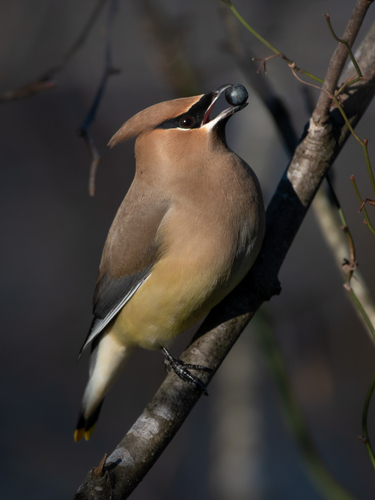
Cedar Waxwing
The Cedar Waxwing (Bombycilla cedrorum) is a sleek, crested bird known for its distinctive appearance and social behavior. These birds are named for their fondness for cedar berries, and their waxy red wingtips add a unique splash of color. Cedar Waxwings play a crucial role in seed dispersal, contributing to the health of forest ecosystems. They are highly social, often seen in flocks, and are known for their gentle nature, even passing berries to one another. Unlike many songbirds, they lack a true song, communicating instead through high-pitched calls.
14-17 cm
Length
22-30 cm
Wingspan
Least Concern
Conservation Status
Distribution
Cedar Waxwings are found throughout North America. Their breeding range extends across southern Canada and the northern United States. During winter, they migrate southwards, reaching as far as Central America and the Caribbean. They are generally not found at high altitudes.
Lifespan
Up to 8 years in the wild, but the average is likely shorter. (Not Evaluated)
Cedar Waxwing's Habitat
Habitat Types
Open woodlands, Forest edges, Orchards, Parks, Suburban areas with fruiting trees
Climate Zones
Temperate, Subtropical
Adaptations
Cedar Waxwings are highly adaptable to various habitats, provided there is a sufficient supply of fruit. Their digestive system is specially adapted to handle large quantities of fruit, allowing them to quickly process and eliminate seeds.
Variations
No clearly defined subspecies are currently recognized, although minor regional variations in size and plumage coloration may exist. These differences are generally subtle and not considered significant enough to warrant subspecies classification.
Appearance
Breeding Plumage
Plumage remains relatively consistent throughout the year. There are no significant differences between breeding and non-breeding plumage.
Seasonal Feather Changes
No significant seasonal changes.
Sex Based Plumage Differences
Males and females have very similar plumage. The number and size of the red waxy tips on the secondary feathers can increase with age, and males tend to have slightly more, but this is not a reliable indicator of sex.
Notable Features
Black mask extending from the bill through the eyes, Yellow-tipped tail, Red waxy tips on secondary wing feathers (variable in number), Crested head
Diet and Feeding
Primary Foods
Berries, Small fruits, Insects
Foraging Behavior
Cedar Waxwings are primarily frugivorous (fruit-eating), especially during the non-breeding season. They often forage in flocks, plucking berries directly from branches. During the breeding season, they also consume insects, catching them on the wing or gleaning them from foliage. They are known to become intoxicated from overripe, fermented fruit.
Specializations
Their digestive system is adapted for rapid processing of fruit, allowing them to consume large quantities and efficiently extract nutrients.
Seasonal Diet Variations
Their diet shifts significantly with the seasons. In winter, they rely almost entirely on fruits. In spring and summer, insects become a more important part of their diet, providing protein for breeding and chick-rearing.
Behavior
Social Structure
Highly social, especially outside of the breeding season. They form flocks that can range from a few dozen to several hundred birds.
Communication
High-pitched 'seee' calls, Whistles
Migration
Cedar Waxwings are nomadic and partially migratory. Their movements are often driven by food availability, particularly fruit crops. Some populations are resident year-round, while others undertake short- to medium-distance migrations.
Territorial or Group Behaviors
They are not strongly territorial, even during the breeding season. While they may defend the immediate area around their nest, they generally tolerate other waxwings nearby. Flocking behavior provides protection from predators and increased foraging efficiency.
Conservation
Threats
Habitat loss (although adaptable), Collisions with windows, Pesticide exposure (indirectly through fruit and insects)
Protection Programs
Migratory Bird Treaty Act (protection in the US, Canada, and Mexico)
Local National Laws
Protected under the Migratory Bird Treaty Act in the United States, Canada, and Mexico.
Population Trend
Stable
Population Estimates
The global population is estimated to be around 64 million. (Partners in Flight)
Interesting Facts
Cedar Waxwings can become intoxicated.
They sometimes gorge themselves on overripe, fermented berries, leading to a state of inebriation.
They are named for their waxy wingtips.
The red tips on their secondary feathers are actually extensions of the feather shafts, coated in a waxy substance.
They are one of the few North American birds that specialize in eating fruit.
Their digestive system is adapted to handle a high-fruit diet.
They often pass food to each other.
This behavior, seen during courtship and within flocks, reinforces social bonds.
Faqs about Cedar Waxwing
What do Cedar Waxwings eat?
They primarily eat berries and other small fruits, but they also eat insects, especially during the breeding season.
Where do Cedar Waxwings live?
They live in open woodlands, forest edges, orchards, and suburban areas with fruiting trees, across North America.
Are Cedar Waxwings migratory?
They are partially migratory and nomadic, with their movements often driven by food availability.
Why do Cedar Waxwings have red tips on their wings?
The red tips are waxy secretions on the ends of their secondary feathers. Their purpose is not fully understood, but they may play a role in mate selection or age signaling.
Do Cedar Waxwings sing?
Cedar Waxwings do not have a true song like many other songbirds. Instead, they communicate using high-pitched calls and whistles.
Copyright @ Nature Style Limited. All Rights Reserved.
 English
English